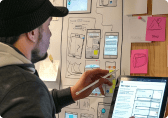
It’s not a Competitive, but a Collaborative Digital World!
The dawn of the digital era has brought the two ‘C’s into great focus – competition and collaboration.
The coming of age of digital technologies, coupled with globalisation, has made the competition more intense. At the same time, competing organisations are also moving towards collaborating to create better product offerings and capture a bigger market share.
Organisations worldwide are trying to improve their digital capabilities, jumping on the digital transformation bandwagon to improve their competitiveness. Even internally, organisations are focused on departmental KRAs and projections. Perhaps the focus on the other ‘C’ – collaboration has never been higher.
It is the collaboration that will make the world of work, work. Whether it is between organisations or within departments, it is collaboration that can accelerate innovation and expand markets and enable ‘open innovation’.
Collaboration in the real world – looking beyond projects and documents.
In this digital world, collaboration extends beyond distance and physical boundaries to make up dynamic teams. However, collaboration is not an activity that is solely restricted to documents and projects.
To boost innovation and increase competitiveness, collaboration has to become a part of the decision-making fabric. And for that, we need data.
Tools that help people work with one another are quite naturally a part of the digital world. We have moved beyond the age of ‘groupware’ – think about the time when Lotus Notes was perhaps the only collaborative software. Today the tools ecosystem is a robust network that can connect teams and departments and help them work with one another.
However, to have a truly connected enterprise, this collaboration has to move beyond the quintessential tools ecosystem and extend it to the organisation’s data environment. To enable real collaboration that boosts innovation and assists robust decision-making, data has to flow seamlessly across departments. Organisations have no option but to remove the silos that divide them and employ the data to design and implement strategies for growth, innovation, and improvement.
Democratising data has its benefits
Today, organisations globally are pushing the envelope to become more ‘data-driven’. But being data-driven is not just about using data. It is more about eliminating data silos and increasing data access to truly democratize data.
This democratisation ensures that data is available anytime-anywhere and every employee with the right authentications knows where to find data and how to use it.
Airbnb is a great example of democratising data science. They ensured that decision-makers have access to the right data at the right time. For this, they made sure that the data science tools are not restricted to the hands of the data scientists alone. Data scientists and business users were empowered to work with data by using highly usable data science tools. The success of this company is evidence that removing data silos and increasing data collaboration leads to smart decisions, which consequently translate to business success.
To build collaboration and increase competitiveness, organisations should focus on building their army of citizen data scientists. For this, encouraging people across the organisation to base their decisions on data and giving them the right tools and platforms ecosystem that allows them to do so with ease is essential.
Operating from a single source of truth
Data is the lifeblood of any organisation today. The sources of data have also increased phenomenally. While this is a great thing, it also leads to a conundrum. With data flowing in from several disparate sources, how can the users know that the data that they are basing decisions on is the right one?
To enable collaboration, organisations have to establish a single source of truth. A single source of truth means that users within the organisation, or in that decision-making network, are basing business decisions on the same data. There is no data disparity, and the correct and the most relevant data is being used for decision-making.
Data has to flow organically and seamlessly across the organisation. A single source of truth helps the organisation speak the same data language. It establishes a concrete foundation for discussion by ensuring that baseline numbers that influence decisions are consistent and dependable.
An inconstancy in the source of truth can lead to different perceptions and impede organisations’ collaborative capabilities. It leads to the ‘Tower of Babel’ syndrome, where different teams are unable to build a business collectively because they do not speak the same data language.
Having the right systems and data platforms helps organisations create a single source of truth and then help them create a single version of the truth. With this information, organisations and teams can collaborate, innovate, and create products and solutions that deliver greater value.
Seeing the big picture
To increase competitiveness, agility, and innovative capacity, departments can no longer remain in isolation and operate in silos. These siloes go against the very grain of digital transformation and the data-driven culture.
In today’s environment, connection has to replace competition at an inter-department or team level. When ideas and decision exchanges happen because data flows organically and seamlessly, organisations can enable impactful collaboration. This collaboration is more impactful because it allows every stakeholder to look at the larger picture and assist in making decisions aligned with greater organisational vision.
Only when data is not restricted in the hands of the IT department alone, it is truly democratised – this is when we can see the full force of collaboration come into effect.
As we dive deeper into the digital world, we realise that competitiveness can be replaced with collaboration – and only with this, we unlock real value for our customers and employees. And as a consequence, we can improve our bottom line.
The one thing that organisations have to make sure though is to enable all their stakeholders and employees with the right data science tools and platforms that are easy-to-use, come with pre-built functions, leverages robust algorithms, and allow everyday business users to play with large data sets.
Only then will we be able to unlock collaboration and take a leap into unchartered territories with confidence.













